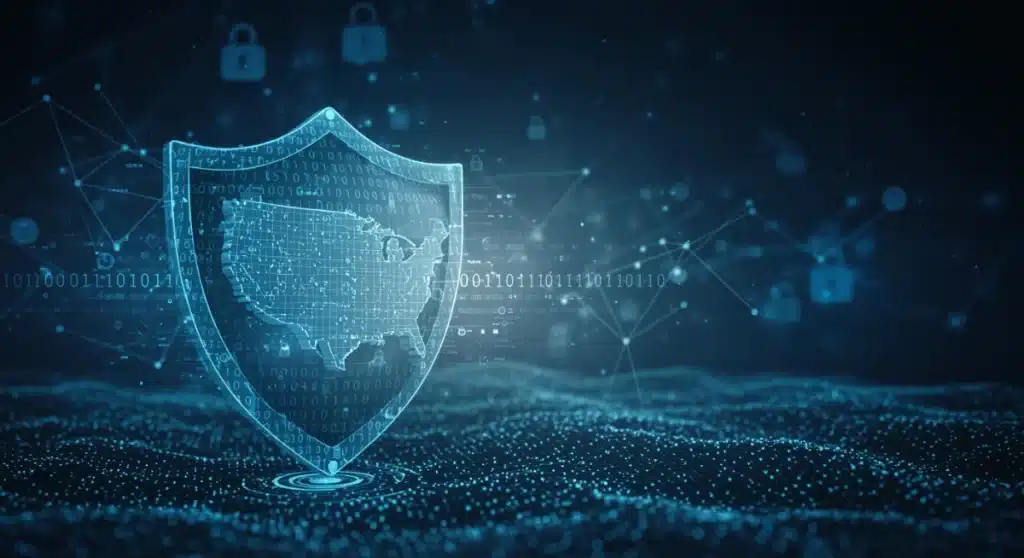2025 Cybersecurity Mandates: Protecting U.S. Business Data

The latest 2025 cybersecurity mandates are poised to significantly reshape how U.S. businesses protect sensitive data, introducing stringent new requirements to counter escalating cyber threats.
U.S. businesses are currently grappling with the impending impact of the latest 2025 cybersecurity mandates: protecting U.S. business data from growing threats.
These new regulations are not just compliance checkboxes but represent a critical shift towards a more resilient national cybersecurity posture. What do these mandates entail, and how will they fundamentally change operational security for companies across the nation?
Understanding the Core of the 2025 Mandates
As cyber threats grow in sophistication and frequency, the U.S. government is responding with a comprehensive set of cybersecurity mandates for 2025. These regulations aim to fortify the digital infrastructure of American businesses, moving beyond reactive measures to proactive defense strategies. The core objective is to create a unified framework for data protection, ensuring that critical business information and national security interests remain safeguarded.
These mandates are a direct response to a series of high-profile data breaches and ransomware attacks that have plagued various sectors, from critical infrastructure to small and medium-sized enterprises (SMEs). Policymakers recognize that a fragmented approach to cybersecurity is no longer sustainable, necessitating a standardized, robust defense across the board.
Key Regulatory Bodies and Their Roles
Several federal agencies are spearheading the development and enforcement of these new mandates. Understanding their distinct roles is crucial for businesses navigating the evolving regulatory landscape.
- CISA (Cybersecurity and Infrastructure Security Agency): CISA is at the forefront, providing guidance, resources, and incident response support. Their focus is on strengthening the security of critical infrastructure and federal networks.
- NIST (National Institute of Standards and Technology): NIST continues to develop and promote cybersecurity standards and guidelines, which often form the technical backbone of federal mandates. The NIST Cybersecurity Framework is a widely adopted voluntary standard now being integrated into mandatory requirements.
- SEC (Securities and Exchange Commission): The SEC’s role primarily focuses on publicly traded companies, requiring them to disclose material cybersecurity incidents and implement robust risk management programs. Their new rules aim to enhance investor protection by ensuring transparency in cyber risk.
These agencies collaborate to ensure a cohesive strategy, although specific requirements may vary based on sector and company size. Businesses must monitor updates from all relevant bodies to ensure full compliance.
Mandates for Critical Infrastructure and Federal Contractors
The 2025 cybersecurity mandates place particular emphasis on critical infrastructure sectors, including energy, transportation, and healthcare, as well as federal contractors. These entities are often targets due to the sensitive nature of their operations and data. New regulations aim to establish a baseline of security that mitigates systemic risks.
For critical infrastructure, the mandates often involve sector-specific performance standards, mandatory incident reporting, and regular vulnerability assessments. Federal contractors, meanwhile, face stricter requirements regarding supply chain security and the protection of controlled unclassified information (CUI).
Enhanced Incident Reporting Requirements
A significant component of the new mandates is the requirement for timely and detailed incident reporting. The aim is to improve national visibility into cyber threats and enable faster, more coordinated responses.
- Reporting Timelines: Many mandates stipulate reporting significant cyber incidents within 24 to 72 hours of discovery, a much tighter window than previously required.
- Information Detail: Businesses must provide comprehensive details about the nature of the attack, its impact, and response measures taken, allowing agencies to understand attack vectors and vulnerabilities.
- Affected Parties: Requirements often include notifying affected individuals or organizations, ensuring transparency and enabling them to take protective action.
Failure to comply with these reporting requirements can result in substantial penalties, underscoring the importance of establishing robust incident response plans and communication protocols.
Impact on Small and Medium-sized Businesses (SMBs)
While often perceived as targets for larger corporations, the 2025 cybersecurity mandates extend their reach to small and medium-sized businesses (SMBs). These mandates acknowledge that SMBs are not only vulnerable but can also serve as entry points for attacks on larger supply chains. The goal is to elevate the overall security posture across the entire economic ecosystem.
For SMBs, compliance might present unique challenges due to limited resources and expertise. However, the mandates emphasize accessible frameworks and support programs to help these businesses adapt. The focus is on implementing foundational cybersecurity practices rather than imposing overly complex technical requirements.
Resource Allocation and Support Programs
Recognizing the potential burden on SMBs, federal and state agencies are developing various initiatives to facilitate compliance.
- Grants and Funding: Some programs offer financial assistance to help SMBs invest in necessary cybersecurity technologies and training.
- Training and Education: Agencies provide free or low-cost training materials, webinars, and workshops to educate SMB owners and employees on best practices.
- Simplified Frameworks: Efforts are underway to create simplified, sector-specific cybersecurity frameworks that are easier for SMBs to implement without extensive technical knowledge.
Despite these supports, SMBs must proactively assess their current security posture and begin planning for compliance well in advance of the 2025 deadlines. This includes conducting risk assessments and developing basic incident response plans.

Key Technological and Procedural Shifts Required
The new mandates necessitate significant technological upgrades and procedural overhauls for U.S. businesses. It’s not merely about purchasing new software but about embedding cybersecurity into the organizational culture and daily operations. Companies must adopt a holistic approach, integrating security at every layer of their digital infrastructure.
From strengthening network defenses to securing endpoints and cloud environments, the technological shifts are broad. Procedurally, businesses need to review and update policies, conduct regular employee training, and establish clear roles and responsibilities for cybersecurity management.
Implementing Zero Trust Architecture
A prominent architectural shift promoted by the 2025 mandates is the adoption of a Zero Trust security model. This model operates on the principle that no user, device, or application should be trusted by default, regardless of its location relative to the network perimeter.
- Continuous Verification: Zero Trust requires continuous verification of identity and access, challenging traditional perimeter-based security.
- Least Privilege Access: Users and devices are granted only the minimum access necessary to perform their tasks, reducing the potential impact of a breach.
- Micro-segmentation: Networks are divided into smaller, isolated segments, limiting lateral movement for attackers if a breach occurs.
Implementing Zero Trust requires a significant investment in identity and access management (IAM) solutions, network segmentation tools, and advanced endpoint security. This architectural change is complex but crucial for achieving the heightened security levels demanded by the mandates.
The Role of AI and Automation in Compliance
Artificial intelligence (AI) and automation are set to play a pivotal role in helping U.S. businesses meet the stringent 2025 cybersecurity mandates. With the sheer volume of data and the complexity of modern cyber threats, manual security processes are increasingly insufficient. AI-driven solutions can enhance threat detection, automate response mechanisms, and streamline compliance reporting, offering a scalable approach to security.
AI algorithms can analyze vast datasets to identify anomalous behavior, detect emerging threats, and predict potential vulnerabilities with greater speed and accuracy than human analysts. Automation, on the other hand, can handle repetitive security tasks, freeing up human experts to focus on strategic initiatives and complex problem-solving. This synergy is essential for maintaining a proactive and resilient cybersecurity posture.
Leveraging AI for Threat Detection and Response
AI’s capabilities are particularly impactful in the areas of threat detection and automated incident response.
- Behavioral Analytics: AI can establish baselines of normal user and network behavior, flagging deviations that may indicate a compromise.
- Automated Remediation: Automated systems can respond to detected threats by isolating affected systems, blocking malicious IP addresses, or deploying patches, often before human intervention is possible.
- Vulnerability Management: AI can continuously scan for vulnerabilities, prioritize them based on risk, and suggest remediation steps, significantly reducing the attack surface.
Integrating AI and automation into existing security operations will be key for businesses aiming to comply with the 2025 mandates efficiently and effectively. It allows for a more dynamic and adaptive defense against sophisticated cyber adversaries.
Penalties for Non-Compliance and Future Outlook
The 2025 cybersecurity mandates are backed by significant penalties for non-compliance, underscoring the government’s commitment to enforcing these new standards. Fines can be substantial, potentially reaching millions of dollars, depending on the severity of the violation, the size of the business, and the impact of any resulting data breach. Beyond monetary penalties, companies may face reputational damage, loss of business, and increased scrutiny from regulators and customers.
The future outlook suggests a continuous evolution of cybersecurity regulations. As technology advances and cyber threats become more sophisticated, mandates are likely to be updated and expanded. Businesses should view the 2025 mandates not as a one-time compliance effort but as part of an ongoing commitment to cybersecurity resilience.
Preparing for Ongoing Regulatory Evolution
Businesses must adopt a forward-thinking approach to cybersecurity, anticipating future regulatory changes.
- Continuous Monitoring: Establish processes for continuously monitoring regulatory updates from relevant agencies.
- Adaptive Security Strategies: Develop flexible security strategies that can adapt to new requirements and emerging threats.
- Investment in Expertise: Invest in skilled cybersecurity professionals or partner with expert third-party providers to stay ahead of the curve.
The 2025 mandates are a clear signal that cybersecurity is no longer a peripheral concern but a fundamental aspect of business operations. Proactive engagement and continuous adaptation will be crucial for long-term success and protection.
| Key Point | Brief Description |
|---|---|
| New Mandates Scope | Broad regulations for critical infrastructure, federal contractors, and SMBs to enhance U.S. data protection. |
| Incident Reporting | Stricter, faster reporting requirements for significant cyber incidents to improve national response. |
| Technological Shifts | Emphasis on Zero Trust, AI, and automation for proactive defense and efficient compliance. |
| Non-Compliance Penalties | Substantial fines and reputational damage for businesses failing to meet new cybersecurity standards. |
Frequently Asked Questions About 2025 Cybersecurity Mandates
The primary goals are to strengthen the U.S. national cybersecurity posture, protect critical infrastructure, enhance data security for businesses of all sizes, and standardize incident reporting. These mandates aim to reduce the overall risk from escalating cyber threats by promoting proactive defense and rapid response capabilities across various sectors.
Businesses in critical infrastructure sectors like energy, transportation, and healthcare are heavily impacted. Federal contractors and publicly traded companies also face stringent requirements. Additionally, small and medium-sized businesses (SMBs) are included, especially those within supply chains, to ensure a comprehensive national security baseline.
Zero Trust is a security model based on the principle of ‘never trust, always verify.’ It requires continuous authentication and authorization for all users and devices, regardless of their location. It’s crucial because it significantly reduces the attack surface and limits lateral movement for attackers, providing a more robust defense against modern threats.
AI and automation can significantly aid compliance by enhancing threat detection through behavioral analytics, automating incident response, and streamlining vulnerability management. They help businesses handle the complexity and volume of security data, providing faster, more accurate insights and freeing human resources for strategic tasks, ensuring efficient and effective defense.
Non-compliance can lead to severe consequences, including substantial financial penalties, which can be millions of dollars depending on the violation’s nature. Additionally, businesses may suffer significant reputational damage, loss of customer trust, and potential legal liabilities, impacting their market position and operational continuity.
What Happens Next
The implementation of the 2025 cybersecurity mandates marks a pivotal moment for U.S. business data protection. We anticipate a period of intense adaptation, with businesses accelerating investments in advanced security technologies and skilled personnel. Regulators will likely increase enforcement actions, setting precedents for compliance expectations. Looking ahead, these mandates are foundational; expect continuous updates and new regulations as the threat landscape evolves, pushing businesses toward an even more resilient and integrated cybersecurity posture. This ongoing evolution underscores the critical need for perpetual vigilance and strategic planning.





